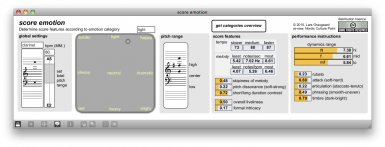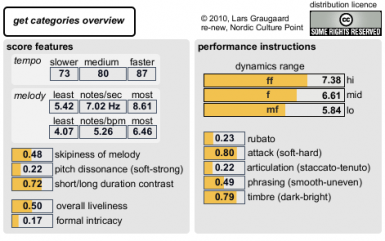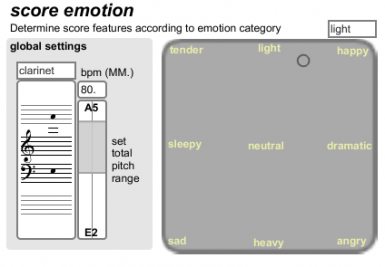Score emotion
This tool determines the boundaries of those score attributes that support emotion expression in music. When an emotion is requested in the two-dimensional emotion field (or the unnamed position between several emotions), the corresponding score attribute boundaries are displayed as a set of ranges.
 The score attributes are divided into score features and performance instructions. The distinction into these groups is because musical emotion has two different sources, namely from the score and that are provided by the performer at the moment of performance.
The score attributes are divided into score features and performance instructions. The distinction into these groups is because musical emotion has two different sources, namely from the score and that are provided by the performer at the moment of performance.
 The score features are tempo, note rate, melodic skipiness, pitch dissonance and duration contrast. Overall liveliness and formal intricacy are also included as score features, even though they are on a higher level and therefore more open to interpretation. Performance instructions are dynamics range and amounts of rubato, attack, articulation, phrasing and timbre.
The score features are tempo, note rate, melodic skipiness, pitch dissonance and duration contrast. Overall liveliness and formal intricacy are also included as score features, even though they are on a higher level and therefore more open to interpretation. Performance instructions are dynamics range and amounts of rubato, attack, articulation, phrasing and timbre.
Eight basic emotions are provided in the two-dimensional field, placed on its corners and sides. Any position between these points will provide the corresponding, interpolated attributes.
 Download the software as a maxpatch or as a stand-alone application for Apple Macintosh.
Download the software as a maxpatch or as a stand-alone application for Apple Macintosh.
Research into emotion expression in music has been very active since Hevner’s first study in 1935. The findings have provided the framework for the present tool, and in particular the the work with the KTH rule system. It is particularly noteworthy that the tool is independent of musical style, and can be applied to the far larger part of western musical styles, as well as very many non-western. The emotional quailties in music are probably somewhat less important in contemporary academic music in the modernistic tradition, which tend to focus on aspects of musical material and its textural possibilities. However, music’s capacity to express emotion is probably its strongest feature, and the reason for its widespread and increasing use in a wide range of human activities.
Sounds can more readily express and arouse emotions than other stimuli.